Incorporated in 2006 in Luxemburg, Spotify is an audio streaming company with hundreds of millions of active users worldwide. Spotify offers its users an exhaustive catalog of music and podcasts. The company has positioned itself as an alternative to pirated music and has built its success upon catering to real demand. Given a practically feasible alternative solution, most people prefer not to pirate music. And Spotify is that feasible alternative.
Not only does Spotify help end users gain legal access to music but also helps creators by forwarding a large chunk of its revenues to them in the form of royalties.
Spotify first made a profit in 2019.
How Spotify Makes its Money
Before you invest in a tech stock, you should understand how the company behind the stock generates revenues. Once you know the business model, you can assess potential and determine whether you should invest.
Here’s how Spotify’s business works.
- The free service attracts a large user base. Spotify offers a free catalog of millions of songs and uses advertising to partially fund this service. Although it only features basic functionality, the free service is a magnet for new clients who get a taste of what Spotify peddles and may opt for a premium upgrade as a result.
- Converting free users to paying customers. Spotify’s approach to building a free user base and converting it to a paying one has been successful. The value proposition that gets free clients to pay for the service consists of the removal of advertisements and the addition of premium features. Almost half of Spotify’s users are paying customers, and they generate around 90% of the company’s revenues.
- Managing client retention. Getting a free user to subscribe to the paid service is one step in the right direction. Retaining paying users and getting them to renew their subscription time and again is where one of the keys to Spotify’s success lies. The customer churn rate of the company hit a record low of 4.6% in 2019. The majority of Spotify’s paying clients renew their subscriptions and continue contributing to the bottom line of the service provider.
- Striking a balance. Spotify depends on four record labels to provide the music it sells to its customers: Sony, Merlin, Warner, and Universal. These four labels provide 85% of the “merchandise” Spotify sells. 52% of the money the streams generate goes to these labels.
- Making enough with the premium service. In Spotify’s business model, the premium service must generate enough to cover the costs of the entire operation. Free service advertising makes some money, but the premium service covers the lion’s share of the operating costs.
Spotify Competitors
Spotify’s competitors are neither few nor insignificant. The audio streaming market is well-saturated with companies like:
- Apple Music
- Amazon Music
- YouTube Music
- Pandora
- Deezer Music
- SoundCloud
To know whether your investment vehicle of choice is capable of generating profits, you must know the entities that could disrupt its business.
How to Buy Spotify Stock?
To buy Spotify stock, you must go through the following steps:
- Compare trading platforms and pick one that suits your needs.
- Open a brokerage account, provide your details, and fund your account.
- Research the stock and ensure that you understand its revenue drivers and potential pitfalls.
- Set the number of shares you wish to buy and pull the trigger right now, at the current market price, or set the price at which you would like to buy in the future.
- Don’t forget to keep your eyes on your investment and observe how it performs.
Spotify continues to accumulate more and more active users, and it has begun expanding its ad-supported revenues.

